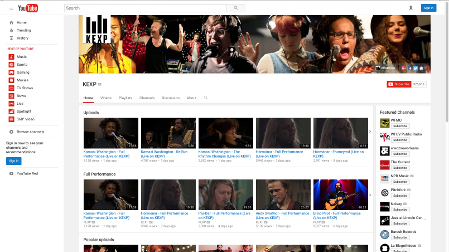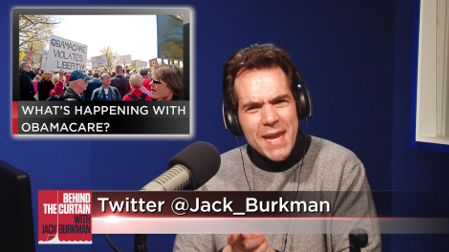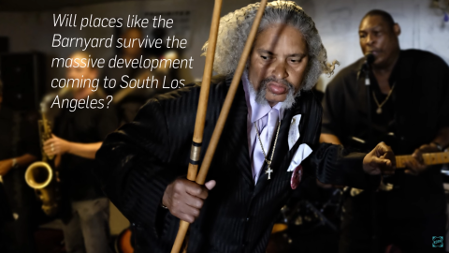Radio Stations Grow Their Video Ambitions
Radio broadcasters across the country are placing more emphasis on live and recorded video, in part to gain traction with their social media platforms.
Experts say webcams and digital video recorders are now common gear for radio broadcasters as they launch additional multimedia channels. Some radio stations are now training personnel as videographers and purchasing programs like Sony Vegas Pro, Final Cut Pro, MediaShout, Logic Pro and ProPresenter to edit video.
Radio stations also are developing video marketing strategies and campaigns for advertising clients in an effort to monetize video products and services.
Here are several examples of radio broadcasters embracing video as a means to expand their listener base:
VIDEO IN EVERY FIBER
Public broadcaster KEXP(FM) in Seattle has found many ways to incorporate video into nearly every fiber of the alternative and indie music radio station.

The KEXP YouTube channel
The professional video industry's #1 source for news, trends and product and tech information. Sign up below.
KEXP video is everywhere on social media from Facebook and YouTube to Instagram and Vimeo. Its new state-of-the-art live performance studio, which opened in 2016, is tricked out with first-class video production facilities so performances by visiting bands can be captured live and later uploaded to YouTube.
Jim Beckmann, online content manager and senior video producer, says he is amazed at the level of the station’s in-house video distribution.
KEXP video began organically, he says, with no real strategy other than a desire to capture some of the bands who were already visiting KEXP to perform in its live room.
“Within several years though, we were filming regularly and noticed that our presence online, particularly on YouTube, was growing to a surprising degree,” Beckmann says.
Today the radio station sees video as a core method for expanding its mission, Beckmann says, which is to champion music and promote discovery.
Beckmann says the radio station considers YouTube as its main digital video platform. KEXP currently has nearly 1 million YouTube subscribers, and this is still where KEXP sees the long tail, “where people continue to discover artists through archived videos that may even be seven or eight years old.”
But the station also shares live music sessions through Facebook Live; even without much promotion, a session there will get thousands of views.
KEXP, which has a video staff of four employees, uses BlackMagic gear to film and live stream video, Beckmann says. Video editing is done with Adobe Premiere. The non-commercial radio station also relies on a handful of volunteers to help with video projects.
Technical tools, though, are only part of what make for good video, he says.
“Matching cameras, good lighting and access to a stable non-linear editing program, whatever it might be, are the most important tools,” Beckmann says. “That, and talented videographers with as much an ear for music as an eye for good framing.”
Beckmann says it is always a challenge to integrate radio and video effectively.
“We are continually looking for ways to bring our vast video viewing audience back to our station, to our website, the online radio stream, the great photographs, engaging events and everything else,” he says. “We are still trying to figure out ways to better connect our YouTube viewers to everything else that’s going on at KEXP.”
VERSATILE SPACE
Radio America, a broadcast network based in Arlington, Va., has built its own video arm of the company. Its hybrid “Video Studio 66” studio consists of two rooms. The studio half includes a green screen, two Sony NXHD cameras and professional lighting while a control booth includes several Mac editors, a Newtek TriCaster video switcher and a Telos Axia control board.
“It’s really a radio studio and video studio. It’s a versatile space that also allows us to do a new community outreach project for our military veterans,” said Rich McFadden, director of operations for Radio America.
The radio network, in cooperation with its sister organization The American Veterans Center, preserves the stories and legacy of vets by telling their stories in video form, McFadden says.
“We have veterans in for tapings with a studio host and that are edited down to four- or five-minute-long oral histories that end up being shared on YouTube and the website www.americanveteranscenter.org,” he said.

Radio America produces a video project for Newsmax TV called “Behind the Curtain” with host Jack Burkman, a registered lobbyist in Washington
Radio America, which serves approximately 500 affiliates as well as American Forces Radio Network and Sirius/XM, also produces a video project for Newsmax TV called “Behind the Curtain” with host Jack Burkman, a registered lobbyist in Washington.
“We try to use video across several different platforms. Our daily shows that we own, including the ‘Chad Benson Show’ and ‘The Dana Show,’ are also in video form. We repurpose nearly all of our radio content for video to be used on Facebook Live, YouTube or Periscope. It’s an easy way to reach a new audience and it’s another outlet for our advertisers. It really builds value for advertisers.”
McFadden, who has used Skype and chat rooms with video for the network’s programming through the years, calls the production of video a big step for radio broadcasters.
“The best tip I can give anyone is to get a Lynda.com account. The online training service has just about any video editing software program or video production training you can think of. Then learn a basic video editing program, whether its Apple’s Final Cut or Adobe Premiere. And learn Photoshop,” McFadden says.
Monetization of video is the next big step for radio, according to McFadden. “We make some money by charging clients for production time. And video is an add-on for our advertisers, but you have to try and create a revenue stream outside of the number of YouTube views.”
And the future of employment in the radio business might soon also depend on a person’s video skills, he said.
“I will tell you that anyone with video skills has their résumé go to the top of the pile here,” McFadden says.
AUDIENCE DIVERSIFICATION
KCRW(FM) in southern California has been at the forefront of using multimedia. The public broadcaster, located in Santa Monica, Calif., started producing video as early as 2000 and launched a YouTube channel 10 years ago. The station has added much more complimentary video since then, including virtual reality film of concerts in its performance space.
Joey Caroni, creative director, strategy and audience development for KCRW, says the station views video as a means to diversify its non-terrestrial listening audience.
“Our video production is quite robust. We are producing content for video and using it as a marketing tool in an effort to drive listening. We have added a lot of video capabilities, like virtual reality, with all new distribution channels to reach a more global audience and introduce the KCRW brand,” Caroni says.
The NPR affiliate is now producing Parallax videos, including companion video for an audio series called “Below the Ten” that examines life for folks in south L.A., Caroni said. Parallax videos use a special effect, utilizing Photoshop, to create motion in images from still photographs that are then combined with audio. (View previous KCRW Parallax videos here.)

KCRW is producing Parallax videos, including a series called “Below the Ten,” which examines life for folks in south L.A. Parallax videos create motion in images from still photographs that are then combined with audio.
“We created a whole new experience that took those audio stories and placed them into a whole new video format. Then we distributed the video to a new audience group via channels like Facebook, YouTube and Instagram, though Instagram is mostly used for short-format video content. Video is much more sharable than just audio on most platforms,” Caroni said.
KCRW began pushing more live video to Facebook in 2016, Caroni says, which resulted in nearly 600,000 live stream views last year.
“We plan on focusing on more dual-format content this year including more episodic podcasts and episodic video series. And we will focus more on distributing video and not just having people come find videos on our website. That’s a big difference. A big chunk of my job is to think about format types and ways to distribute video.”
Caroni said the AAA format station is expecting to push more video through Periscope this year, not just live events but also produced content.
“We are also looking to get KCRW into the mix of video content producers used by other distribution channels that aggregate content for audiences. I think that is the next step for us. We have a wealth of culture and music content to share on video,” Caroni says.
The radio station, which employs two full-time video producers/editors, uses a range of video editing tools, including Final Cut Pro, Adobe Premiere, Adobe After Effects, Adobe Illustrator and PluralEyes.
Caroni says he encourages radio broadcasters interested in venturing into video to invest in some low-tier hardware first, such as placing GoPro cameras in master control to simply “pull back the curtain” on radio.
“There are those who want to watch radio to see how it works. That’s very low hanging fruit that’s easy to pick. You start there and then you develop projects by maybe partnering with a local production house that has video expertise. They might very well be interested in the access you can grant them,” he says.
“Also reach out to local artists who work in video and leverage the exposure you can give them. There are people with video cameras who have the desire to build their portfolio and are interested in working with other media creators.”
Randy J. Stine has spent the past 40 years working in audio production and broadcast radio news. He joined Radio World in 1997 and covers new technology and regulatory issues. He has a B.A. in journalism from Michigan State University.
